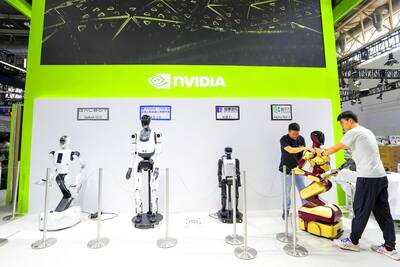Huawei Technologies Co (華為), China’s largest maker of telephone equipment, said revenue exceeded US$32 billion last year, narrowing its gap behind Ericsson AB.
Revenue grew about 11 percent last year, William Xu (徐文偉), a Huawei board member and president in charge of its enterprise division, said in an interview at the Mobile World Congress in Barcelona, Spain, citing preliminary figures. The Shenzhen-based company also met its profit targets, helped by sales of mobile devices and growth at the enterprise business, he said.
Huawei’s revenue was about 50 percent more than France’s Alcatel Lucent, which sells fewer products than Huawei. Stockholm-based Ericsson, the biggest maker of wireless network equipment, reported sales last year of 227 billion kronor (US$34.5 billion).
Chief executive officer Ren Zhengfei (任正非) is adding cloud computing and business computing services as well as sales of smartphones and tablets as Huawei works on a goal of generating US$100 billion in sales.
“The networks are converging, from the terminal to the infrastructure, supported by cloud computing and applications,” Xu said in the interview on Tuesday.
“Huawei in the future could be one of the leading companies” in the field of information and telecommunications systems, he said.
Growth at Huawei Enterprise may be slower than originally anticipated, Xu said, adding that US$15 billion in contract revenue by 2015 is a more realistic target.
Leon He, another Huawei executive, in May last year gave a sales projection of US$15 billion to US$20 billion for the division.

UNCERTAINTIES: Exports surged 34.1% and private investment grew 7.03% to outpace expectations in the first half, although US tariffs could stall momentum The Chung-Hua Institution for Economic Research (CIER, 中華經濟研究院) yesterday raised its GDP growth forecast to 3.05 percent this year on a robust first-half performance, but warned that US tariff threats and external uncertainty could stall momentum in the second half of the year. “The first half proved exceptionally strong, allowing room for optimism,” CIER president Lien Hsien-ming (連賢明) said. “But the growth momentum may slow moving forward due to US tariffs.” The tariff threat poses definite downside risks, although the scale of the impact remains unclear given the unpredictability of US President Donald Trump’s policies, Lien said. Despite the headwinds, Taiwan is likely

When Lika Megreladze was a child, life in her native western Georgian region of Guria revolved around tea. Her mother worked for decades as a scientist at the Soviet Union’s Institute of Tea and Subtropical Crops in the village of Anaseuli, Georgia, perfecting cultivation methods for a Georgian tea industry that supplied the bulk of the vast communist state’s brews. “When I was a child, this was only my mum’s workplace. Only later I realized that it was something big,” she said. Now, the institute lies abandoned. Yellowed papers are strewn around its decaying corridors, and a statue of Soviet founder Vladimir Lenin

UNIFYING OPPOSITION: Numerous companies have registered complaints over the potential levies, bringing together rival automakers in voicing their reservations US President Donald Trump is readying plans for industry-specific tariffs to kick in alongside his country-by-country duties in two weeks, ramping up his push to reshape the US’ standing in the global trading system by penalizing purchases from abroad. Administration officials could release details of Trump’s planned 50 percent duty on copper in the days before they are set to take effect on Friday next week, a person familiar with the matter said. That is the same date Trump’s “reciprocal” levies on products from more than 100 nations are slated to begin. Trump on Tuesday said that he is likely to impose tariffs

READY TO BUY: Shortly after Nvidia announced the approval, Chinese firms scrambled to order the H20 GPUs, which the company must send to the US government for approval Nvidia Corp chief executive officer Jensen Huang (黃仁勳) late on Monday said the technology giant has won approval from US President Donald Trump’s administration to sell its advanced H20 graphics processing units (GPUs) used to develop artificial intelligence (AI) to China. The news came in a company blog post late on Monday and Huang also spoke about the coup on China’s state-run China Global Television Network in remarks shown on X. “The US government has assured Nvidia that licenses will be granted, and Nvidia hopes to start deliveries soon,” the post said. “Today, I’m announcing that the US government has approved for us